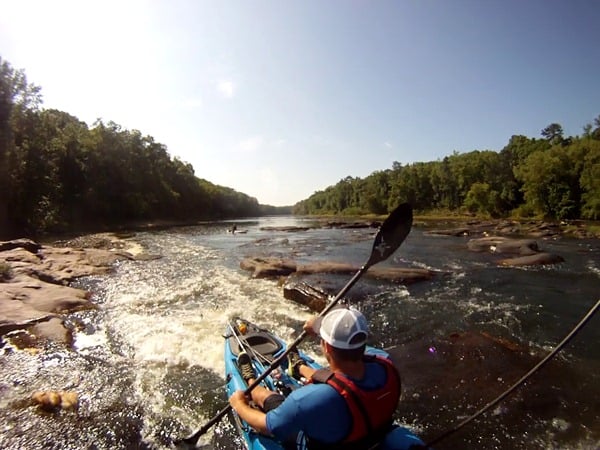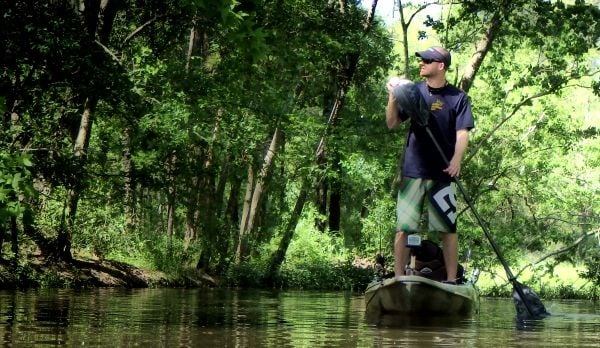For most of the general population, talk of a river boat conjures up images of a coal-fired paddle wheeler lumbering along the Mississippi River. For the anglers who chase fish in the swirling water of their local flow, a river boat is a totally different critter.

Drew Gregory on the Flint river with a Jackson Coosa
It can be argued that any kayak can be used to fish a river, but there is little doubt that some are much better suited for the task. I have river fished out of canoes, hybrids and multiple makes of sit-on-top kayaks, and in slower flows there was never an issue. It is when the rapids start breaking over your bow and the gentle flow turns to white water that a real river kayak will rise above the rest. These boats are designed for rough water and fast flows, so anglers can get to the fish that hide in the ambush spots along the way.
Drew Haerer running a set of rapids on the upper Flint River, GA in his Malibu Stealth 12
Maneuverability is a major need for a river-running kayak. Having the ability to run across flows and spin into an eddy is important for fishing as well as safety. A kayak that tracks straight as an arrow may be a dream on the flats, but will not be able to turn and avoid hazards in a swift-moving flow. River boats will have a slight “rocker” (banana shape to the hull) that will make them nimble like their whitewater play boat cousins. This will allow you to stay in an eddy while fishing, or while studying your next path of travel.
Matthew Frazier with a nice eddy caught bass while fishing in his Native Watercraft Slayer 12
Volume in the bow or an upswept bow is another thing to look for. This will help force the nose of the kayak up on top of standing waves instead of plowing right through them. Having your bow on top of the wave will allow you to turn quickly to make sure you can follow the best line through rough water. These attributes also make it easier to paddle back up river to hit a hole you may have missed while running through.I would also look at how gear stores or straps on any kayak bound for a river. On slow flows it is not an issue, but in more aggressive water the ability to lash down gear or store it in the hull is good. This will help prevent a costly gear loss if you crash and burn in a rapid. A standing wave that washes across your deck can remove gear with it, as well. Having rods and tackle lashed or bungee corded down will make sure you end up with the same amount of gear you started with.
Several manufacturers make kayaks that will serve a paddler well on rivers. It really comes down to paddling as many as you can, and seeing what fits your style and budget. Some of the most mentioned kayaks for river fishing in various outdoor forums are:
Malibu Stealth 12

Drew Haerer setting the hook on a Suwannee Bass while standing and pitching to grass mats in the Santa Fe River, FL
Native Slayer 12
Luke breakfield stalking bass in a Slayer 12
FeelFree Moken 12.5
Matt Phillips SUP's in his Moken 12.5 on a section of the San Jacinto River near Houston, TX
Jackson Kayak Coosa
Brooks Beatty paddling the Flint River looking for shoal bass.
When fishing any river from a kayak, safety has to be a priority. Along with your river boat, get the best PFD you can afford and wear it at all times. Tell a friend or family member where you are fishing, and when to expect you at home. Know what to do if you “wet exit” the kayak, and have a plan in place in case should that happen. With a little preparation and a lot of safety, a good river boat may just open a whole new world of fishing for you.Special thanks to: Drew Haerer, Matt Phillips, and Matthew Frazier for the additional photos of the Malibu Stealth 12, Moken 12.5, and Slayer 12
Full Article: Yakangler

No comments:
Post a Comment